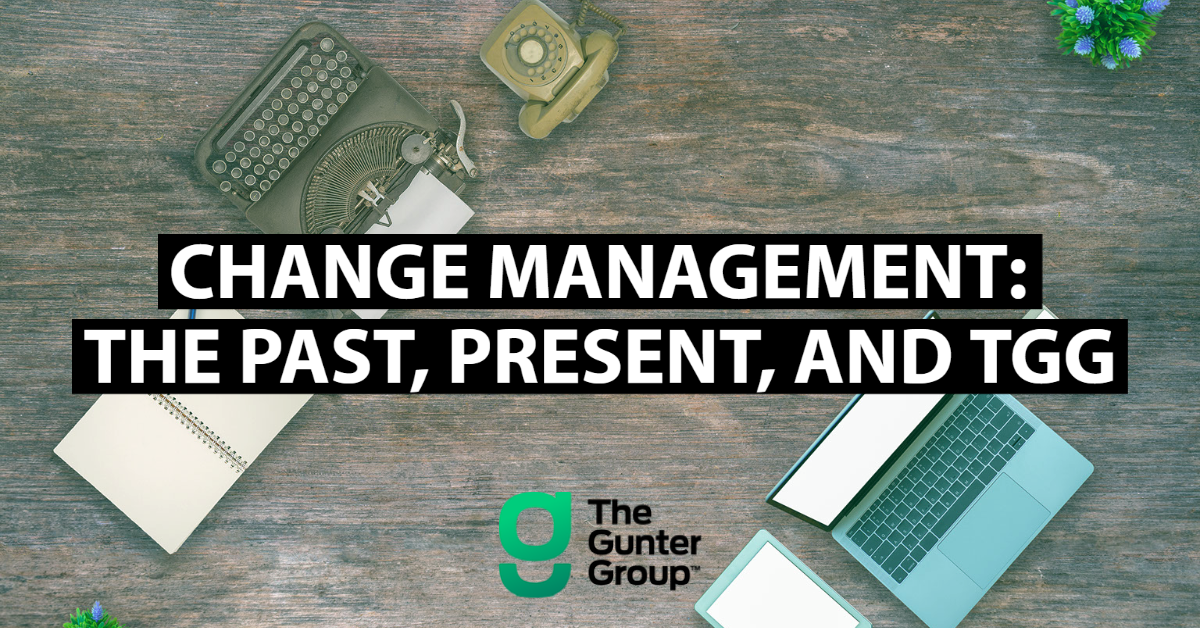CHANGE MANAGEMENT:
THE PAST, PRESENT, AND TGG

People are hardwired to be cautious of change. However, in today’s rapidly-evolving business climate, organizations must find ways to support employees through inevitable changes. From operational restructuring to software implementations and everything in between, the field (and process) of change management is complex.
With the numerous methods, techniques, and approaches to change management how does an organization identify and pinpoint the best path forward?
It will help to briefly travel back in time to understand the roots of the formalized practices that flourish today and break down three foundational pillars of change management that organizations can utilize today.
The Migration From Psychology To Business
Change management has roots in the study of human behavior. The intellectual beginnings trace to the early 1900’s, into the work of the anthropologist Arnold van Gennep. When looking at rites of passage in different cultures, Gennep began to notice common behaviors.
Even though he was looking at a variety of different cultures, he noticed that there were three overall states that ran common in the experience of social change. The first state was a “pre-liminal” stage, where the coming change was acknowledged and prepared for by the community.
The middle state was the “liminal” stage, which he defined as a threshold of ambiguity and disorientation. Change managers everywhere will chuckle at the accuracy of adjectives like “ambiguity” and “disorientation” when describing the liminality of change.
The final state in a rite of passage was “post-liminal,” where the transition in status was recognized and normalized in the community. Across cultures and belief systems, Gennep was able to identify these common movements in the human experience of change.
By the mid-20th century, when psychology began to blossom into a robust and complex discipline of study, Gennep’s three states gained popularity. In the 1940’s, Kurt Lewin became a pioneer in social and organizational psychology by turning his attention to understanding change. Lewin borrowed from Gennep’s structure and described a three step process for change: unfreezing, changing, and refreezing.
There was some academic buzz from several sources in the years following Lewin’s work, but no substantial leap from psychology to business had yet been made. This changed in 1982, when a consultant at McKinsey named Julien Phillips published an article in the journal Human Resource Management.
In his article, Phillips introduced a model for organizational change management specifically designed with businesses in mind. His model defines four steps that were intended to build momentum for change within an organization: creating a sense of concern, developing a specific commitment to change, pushing for major change, and reinforcing the new course of action.
In the years following, change management took off. Books were published; articles became more frequent; new models were advanced. Businesses were in need of assistance with change, and consultants pursued thought leadership that would help address this need and grow their business. Peters, Waterman, Kotter, and dozens more developed robust philosophies and methods for change, and organizations bought in and helped the field to grow.
Today, there are as many models for change management as there are consulting organizations. Looking for a 4 step process? Try PDCA. Interested in 5 steps? Try ADKAR. How about a 6 step approach? Try Pulse. Need more? Try Kotter’s 8 Steps, or Prosci’s 9 Steps. There are symposiums and communities of practice such as Prosci and ACMP; and naturally a veritable cornucopia of certifications abound. Change management is so saturated with models and approaches that some even try to push “beyond change management.”
100 Frameworks, 1 Idea
The Gunter Group does not subscribe to any one framework. Our clients are too unique for a single set of steps to be the answer. We proudly proclaim ourselves to be “methodologically agnostic,” much more interested in understanding the organization than blindly peddling a process that fails to fit the people it is meant to help.
That is not to say that we don’t know the methods. Our consultants have expertise in Prosci and ADKAR; and we have a number of tangentially relevant certifications (Six Sigma, SAFe, PMP, and HCD to name a few); we attend local ACMP events. We do not, however, learn a method to become disciples. Rather, we expose ourselves to frameworks and study methodological vocabulary to leverage those aspects of the frameworks that might be helpful for our work. Our clients appreciate a tailored approach that is grounded in the best practices of 100 frameworks.
This approach to consulting reveals something obvious: all change management methods are basically the same. Decades of scholarship and praxis have not changed the core phases of change, and wisdom that dates back a century still lies at the heart of responsible change. There are 3 basic phases in change (before, during, and after), and every change management framework simply iterates on the approach taken within those three phases.
So what runs common throughout all change management? What activities should you keep in mind as you tailor the process to your specific organization? We’ll run through the basics below.
Step 1: Pre-Change
Change is coming. Perhaps it is a changing regulation, a new technology, an upcoming merger, or a poor quarterly report; whatever the reason, you see change on the horizon and understand that you will need to prepare for it. Though the various frameworks approach preparing for change differently, three key activities take place during pre-change: analysis, planning, and influencing.
Analysis comes first. Before you can plan for change, you have to understand the people and processes that will be impacted. Who will be your champions, sponsors, and resistors? Helpful tools for this phase include stakeholder matrices, current state and future state process maps, and change impact assessments. The change manager must also understand the change itself. Without a powerful grasp on the “why” that is driving the change, planning and execution will fall short.
Planning comes next. Change management occurs somewhere between the intersection of strategy, people, and execution, and planning is the bridge that brings these three elements into alignment. This includes planning for the change itself, communication that will accompany the change, and the training that will make the change possible.
Influencing should follow. ADKAR describes this as fostering awareness and desire. Prosci speaks of sponsors and champions. Other schools of thought suggest using concepts like vision or need. We have found that a cocktail of all these approaches is usually the best way forward.
Step 2: Change
You’ve spent time interviewing stakeholders, mapping processes, and planning training sessions; now it’s time to introduce the change. This is messy, confusing, and difficult for the people impacted so change managers often rely most heavily on a methodology in this phase. However, mid-change is where a generalist approach could be most advantageous, adapting to the ongoing needs of the situation. There are four activities that always occur in any well-managed change approach: communication, training, changing, and reinforcement.
The most important activity surrounding change is communication. This is where you lean heavily on the results of your analyses. You know who needs communication, what they need to hear, and how it will affect their work flow. Armed with this information, you can plan accordingly, communicating the upcoming movements to the right people, early and often.
Another essential activity is training. This often goes hand-in-hand with communication, and is best when designed from the viewpoint of those impacted. Recent developments of tools such as Human Centered Design help maximize the value of training.
At a certain point, the change will happen. Kotter recommends an approach of small-slicing the change to create short term wins, but often the change manager is not the one driving the project timeline. When it comes to go-lives, change managers serve a thousand roles. They become SME’s for elements of the change impact; they attempt to remove obstacles from stakeholders; they act as cheerleaders or bulldogs, whatever is called for in the moment.
As change occurs, another important activity is reinforcement. A big part of this is engaging program or organizational-wide leadership to enforce the change. This activity truly begins in pre-change and extends through the end of post-change, but it becomes extremely important in the midst of the change. There are approaches coming out of organizational psychology that can be helpful here, such as Vroom’s Theory of Motivation, McClellan’s Theory of Three Needs, or McGregor’s Theory X and Theory Y.
Step 3: Post-Change
Follow-through is a must. As Gennep would say: the new status must be confirmed and the change must be reincorporated as the new norm. This is done a little differently in each framework, but necessary activities include reinforcement and reanalysis.
As said above, reinforcement is heavily featured in post-change activities. The goal is longevity, driving the change through ongoing champions and dwindling resistance. Success is celebrated, momentum is reinforced, and improvements are consolidated. Through these activities, the new order is anchored in behavior.
One often-forgotten activity that takes place after the change occurs is reanalysis. Throughout this whole process, you’ve generated a mountain of information, from stakeholder input to process metrics. Current-state assessments performed before, during, and after the change are a great way to analyze that information, evaluating the effect of the change.
Change management is the study of human behavior. Change is inevitably difficult for humans, yet change is unavoidable. As professionals in change management, we bring a people-centered approach to our work. We partner with clients to ensure employees and stakeholders understand, support, and adopt the desired change and it starts with a very critical element: listening. We view our clients’ change as if it was our change, and their people, as if they were our people, with a foundation of respect.
